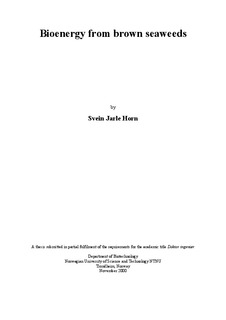| dc.contributor.author | Horn, Svein Jarle | nb_NO |
| dc.date.accessioned | 2014-12-19T13:14:10Z | |
| dc.date.available | 2014-12-19T13:14:10Z | |
| dc.date.created | 2000-12-13 | nb_NO |
| dc.date.issued | 2000 | nb_NO |
| dc.identifier | 125539 | nb_NO |
| dc.identifier.isbn | 82-7984-134-2 | nb_NO |
| dc.identifier.uri | http://hdl.handle.net/11250/245590 | |
| dc.description.abstract | Brown seaweeds lack lignin and have a low cellulose content. Thus, seaweeds should be an easier material for biological degradation than land plants. However, seaweeds have a complex composition, and complete degradation of the material necessitates the presence of microorganisms with a broad substrate range. During anaerobic degradation of organic material, energy carriers such as methane and ethanol may be produced. This is a study of two particular species of brown seaweeds; Laminaria hyperborea and Ascophyllum nodosum, which are the most abundant Norwegian species and also the two species that are commercially harvested in Norway.
Most of the degradation studies were carried out in batch systems at pH 7 and at 35 °C. The digestion pattern of the seaweeds were studied by measuring gas production, alginate lyase activity, remaining alginate, the concentrations of uronic acids, VS, COD, mannitol, organic acids and polyphenols. NIR spectroscopy was applied as a new method for alginate quantification. Ethanol production was carried out at 30 °C at different pH, both in batch and continuous cultures. Gas production and concentrations of mannitol, laminaran, ethanol and organic acids were measured.
Methane is the end product of a mixed microbial community. However, it is the initial steps of hydrolysis and acidogenesis that are specific for the raw material. Alginate forms the major structural component of brown algae, and its degradation is catalysed by alginate lyases. Polyphenols proved to be the most important limiting factor in the biodegradation: the content of polyphenols was much higher in A. nodosum than L. hyperborea, and this led to a reduced biodegradability of A. nodosum. However, when the polyphenols were fixed with formaldehyde, this seaweed was also readily degraded. Manipulation of the content of polyphenols in L. hyperborea gave similar results. This toxic effect was probably caused by direct inhibition of the microbes, especially the methanogenic bacteria, and complexation reactions with algal material and enzymes. Generally, the guluronate content of the remaining alginate increased during biodegradation, probably due to the Ca-linked guluronate junction zones less accessible for alginate lyase. The main organic product of the acidogenesis was acetate, which was easily converted to methane. In this study, it was not attempted to optimise the methane yield.
Ethanol is an intermediate in the complete digestion of organic material and is produced by specific microbial strains. Thus, ethanol production should take place under controlled conditions to prevent contamination problems. The complex composition of seaweeds makes it a difficult substrate to ferment to ethanol by one or a few strains of microbes. In this work, laminaran and mannitol extracted from L hyperborea fronds were used as substrate for ethanol production. A bacterium, Zymobacter palmae, was able to produce ethanol from mannitol, but could not utilise laminaran. However, the yeast Pichia angophorae was able to produce ethanol from both substrates simultaneously. Some supply of oxygen was necessary for the fermentation of mannitol, while a too high aeration resulted in the production of organic acids.
Thus, it has been shown that both methane and ethanol can be produced from brown seaweeds. However, an optimisation of the processes will be necessary. Energy production from seaweeds will only be economic if the harvesting costs are low. It may be noted that wastes from the alginate industry may be considered a non-cost raw material for energy production. | nb_NO |
| dc.language | eng | nb_NO |
| dc.publisher | Fakultet for naturvitenskap og teknologi | nb_NO |
| dc.relation.ispartofseries | Dr. ingeniøravhandling, 0809-103X; 2000:105 | nb_NO |
| dc.relation.haspart | Horn, SJ; Moen, E; Østgaard, K. Direct determination of alginate content in brown algea by near infra-red (NIR) spectroscopy. J. appl. Phycol.. 11(1): 9-13, 1999. | nb_NO |
| dc.relation.haspart | Moen, E; Horn, SJ; Østgaard, K. Biological degradation of Ascophyllum nodosum. J. appl. Phycol. 9: 347-357, 1997. | nb_NO |
| dc.relation.haspart | Horn, SJ; Østgaard, K. Alginate lyase activity and acidogenesis during fermentation of Laminaria hyperborea.. J. appl. Phycol.. 13: 143-152, 2001. | nb_NO |
| dc.relation.haspart | Horn, SJ; Aasen, IM; Østgaard, K. Production of ethanol from mannitol by Zymobacter palmae. J. ind. Microbiol. Biotechnol.. 24(1): 51-57, 2000. | nb_NO |
| dc.relation.haspart | Horn, SJ; Aasen, IM; Østgaard, K. Ethanol production from seaweed extract. J. ind. Microbiol. Biotechnol. 25(5): 249-254, 2000. | nb_NO |
| dc.subject | Biotechnology | en_GB |
| dc.subject | TECHNOLOGY: Bioengineering | en_GB |
| dc.title | Bioenergy from brown seaweeds | nb_NO |
| dc.type | Doctoral thesis | nb_NO |
| dc.source.pagenumber | 84 | nb_NO |
| dc.contributor.department | Norges teknisk-naturvitenskapelige universitet, Fakultet for naturvitenskap og teknologi, Institutt for bioteknologi | nb_NO |
| dc.description.degree | dr.ing. | nb_NO |
| dc.description.degree | dr.ing. | en_GB |
